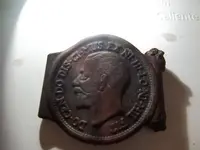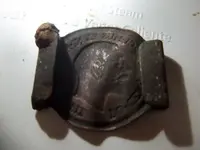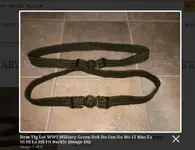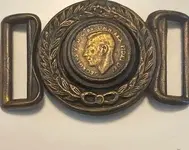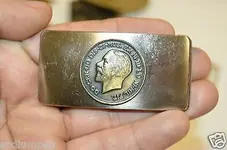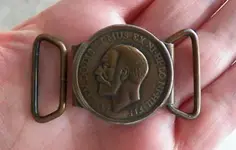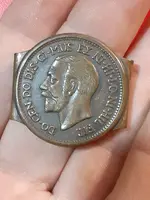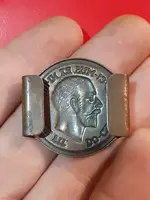Seems to be a popular motif for buckles and money clips,l. Some look like actual coins were used, others are crude representations. Agree it's George V.....I'm far from an expert, but I agree, I'm not finding a military connection.
View attachment 1983244View attachment 1983245View attachment 1983246
The portraits for these belt buckles do seem to be copied from British coinage and are usually George V, but the first example pictured above is actually George
VI. The others could date as early as 1911, but that one
couldn’t be before 1937 (see *Footnote).
I can’t imagine why any US military item would use the imagery of British monarchs. Canada possibly, but not the US. I also saw the ebay listing where the seller said he was offering a “
US Marine Corps 1912 enlisted man's uniform grouping (winter tunic and trouser set in Forest Green wool)” which had one of these belts around the trousers. I don’t think the belt originally belonged to the uniform set. Others feeding off that ebay listing seem to have given it more credence than it deserved… ie a myth was born.
The legend “DOCENDO DISCIMUS EX NIHILO NIHIL FIT”, curiously broken as “DO-CEN-DO DIS-CI-MUS. EX-NI-HI-LO NI-HIL FIT" means “We learn by teaching. From nothing comes nothing”, which would be rather odd for a military item. Some sources suggest the belts to be fraternal/Freemasonry related, which I think makes a lot more sense. Certainly some Masonic lodges used the “Docendo Discimus” motto, if not the “Ex Nihilo Nihil Fit” part.
In 1919, George V (then a serving Lieutenant in the Royal Navy) sought admission to the Freemason’s Navy Lodge No. 2612 (his grandfather had been the founding Master). His son George (later to be George VI) was admitted at the same time and similarly active. There was wide press coverage of their involvement (in contrast to the more usual low public profile of Masonic activity). George V was later made a ‘permanent’ Provincial Grand Master, circumventing the protocol that reigning monarchs should not hold Masonic offices.
One event that received even more prominent coverage came as a result of the planning in 1935 for the bicentennial of the Grand Lodge of Scotland. They expected to have the patronage of the as-yet uncrowned George VI as Royal Grand Master, which was fine because after the death of George V in January 1936, the next in line for the throne was Edward VIII. George could therefore be invested with and retain Masonic offices in time for the bicentennial. Events overtook them when Edward VIII abdicated and George was unexpectedly ‘promoted’ to King as George VI. The Craft didn’t want to lose the royal connection, so George was made a ‘Past Grand Master’ and duly invested as such at an Especial Grand Lodge held at the Royal Albert Hall on 30 June 1937.
My gut feel is that these belts (both the George V and George VI ones) relate in some way to these events.
[*Footnote: As most folks know, there has been a long-standing British tradition dating back to the 17th Century that the coinage portrait for each monarch faces the opposite direction to the preceding monarch. The tradition arose when Charles II refused to face the same way on his coinage as the republican dictator Oliver Cromwell had on his. So, the sequence should have been:
George V (1910-1936; portrait in use from 1911): Facing left.
George VI (1936-1952; portrait in use from 1937): Facing right.
However,
both monarchs have left-facing portraits. The reason is that in 1936 we had a monarch who abdicated before his coronation… Edward VIII. By tradition he should have faced right but, for reasons of vanity related to his ‘comb-over’, he insisted on facing left and, after some argument, got his own way. Coinage dies were prepared with a left-facing portrait that met his approval but never used (apart from a few rare patterns and small number of trial pieces that ‘escaped’ from the Royal Mint).
When George VI stepped up to the throne in his place, there was much debate concerning how the tradition should continue. It was ultimately decided that since Edward should
theoretically have faced right, then the tradition would continue as if he had, with George VI facing left.]



